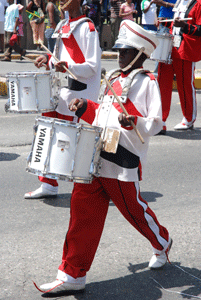February is Black History Month. Every year there’s a different theme for February’s celebration. For 2014, the theme is The Golden Jubilee of the Civil Rights Act.
The Civil Rights Act of 1964, which ended segregation in public places and banned employment discrimination on the basis of race, color, religion, sex or national origin, is considered one of the crowning legislative achievements of the civil rights movement. First proposed by President John F. Kennedy, it survived strong opposition from southern members of Congress and was then signed into law by Kennedy’s successor, Lyndon B. Johnson. In subsequent years, Congress expanded the act and also passed additional legislation aimed at bringing equality to African Americans, such as the Voting Rights Act of 1965.
Carter G. Woodson, Father of Black History
A profile of the founder of Black History Month
Carter G. Woodson
By Lerone Bennett, Jr.
One of the most inspiring and instructive stories in black history is the story of how Carter G. Woodson, the father of black history, saved himself for the history he saved and transformed.
The skeletal facts of his personal struggle for light and of his rise from the coal mines of West Virginia to the summit of academic achievement are eloquent in and of themselves and can be briefly stated.
At 17, the young man who was called by history to reveal black history was an untutored coal miner. At 19, after teaching himself the fundamentals of English and arithmetic, he entered high [secondary] school and mastered the four-year curriculum in less than two years.
At 22, after two-thirds of a year at Berea College in Kentucky, he returned to the coal mines and studied Latin and Greek between trips to the mine shafts. He then went on to the University of Chicago, where he received bachelor’s and master’s degrees, and Harvard University, where he became the second black to receive a doctorate in history.
The rest is history — black history.
For in an extraordinary career spanning three crucial decades, the man and the history became one — so much so that it is impossible to deal with the history of black people without touching, at some point, the personal history of Carter Woodson, who taught the teachers, transformed the vision of the masses and became, almost despite himself, an institution, a cause and a month. One could go further and say that the systematic and scientific study of black history began with Woodson, who almost single-handedly created the Association for the Study of Negro Life and History (now the Association for the Study of Afro-American Life and History) and the prestigious Journal of Negro History. Not content with these achievements, he ventured into the field of mass education, creating the annual black history celebrations.
What makes this all the more remarkable is that Woodson created these cultural monuments largely by his own efforts. Defiantly independent, he gave up the things most men hold dear — family, material comforts, fun and social relations — and devoted his every waking hour to the task of ensuring that blacks would escape “the awful fate of becoming a negligible factor in world thought.” Like most pioneers, he was ridiculed and attacked. But in the end, he prevailed.
It was no accident, historian John Hope Franklin once said, that Carter G. Woodson accomplished these things. History knew what it was doing when it gave James Henry and Anne Eliza Woodson, two former slaves, the honor of bringing Carter G. Woodson into the world on December 19, 1875, a bare 10 years after the end of the U.S. Civil War, in New Canton, Virginia. The Woodson family was impoverished and oppressed, and the future scholar’s childhood was bleak and unpromising. Like so many of his contemporaries, he was denied education, partly because there were few black schools, partly because his father needed his hands in the fields. But unlike many of his playmates, he created an inviolate place within. More than this, deeper than this, he perceived early, as pioneer black educators Mary McLeod Bethune and Benjamin E. Mays and others perceived in similar circumstances, that the key to his dungeon was education. And he decided early that he was willing to do almost anything to get that key.
Driven by this need, young Carter, aided by two uncles, taught himself the ABCs between backbreaking hours in the field. Then, accompanied by his brother, he moved in 1892 to Huntington, West Virginia, which had one of those rarities of the time, a high school for black students. To get money to finance his education, he went to work in the coal mines, braving falling rocks, accidental explosions and poisonous gases. He was injured one day by falling slate, but he never turned back.
“Nothing could stop Carter,” a cousin, John Riddle, said. “He didn’t stay in the mines long. He was always interested in getting an education.”
In fact, Woodson served, as he said later, a six-year “apprenticeship” in the mines. He was 19 years old when he enrolled at Douglass High School. After graduation and several semesters at Berea College and a teaching assignment in Winona, West Virginia, he returned to Douglass High School, four years after his graduation, as principal. There then followed an interlude of teaching in the Philippines and graduate study at the University of Chicago and Harvard. In 1909, he turned a major fork of destiny, settling down to a 10-year stint of teaching in Washington.
“When I arrived in Washington in 1909 and began my research,” he said later, “the people there laughed at me and especially at my `hayseed’ clothes. At that time I didn’t have enough money to pay for a haircut. When I, in my poverty, had the `audacity’ to write a book on the Negro, the `scholarly’ people of Washington laughed at it.”
The laughing stopped in 1915. In the summer of that year, the 39-year-old teacher received an invitation to a Negro folklore conference at the University of Chicago. Woodson turned the invitation down, saying with characteristic bluntness that he was not a folklorist and that he didn’t think the conference would accomplish anything. He told the organizers “that something else was taking shape in his mind.”
The “something else” was quite unprecedented, a national black historical society. Woodson planned to organize the scholarly association with flourishes and fanfare at a national conference. This plan, however, was abandoned, he said, “for the reason that it was not believed that a large number of persons would pay any attention to the movement until an actual demonstration as to the possibilities of the field had been made.” Woodson believed in the power of the deed. To his dying day, he believed that the actual is more compelling than the potential and that one ounce of real work is worth more than a ton of speeches and resolutions.
So believing and so saying, he asked a handful of men to “join him in organizing, so to speak, in a corner.” The corner was the office of the director of the Wabash Avenue YMCA (a social organization) in Chicago. There, on September 9, 1915, Woodson and four others organized the Association for the Study of Negro Life and History. The purposes of the organization, in Woodson’s words, were “the collection of sociological and historical data on the Negro, the study of peoples of African blood, the publishing of books in the field, and the promotion of harmony between the races by acquainting the one with the other.”
In the beginning — and for a long time thereafter — the association was a one-man show with Woodson producing, directing, writing, organizing, sweeping the floor and providing most of the money. Even after the organization was launched, he said later, “few of the members were anxious to assume any pecuniary responsibility and therefore urged further delay before undertaking to carry out the program.”
Delay was not Woodson’s style. And so on January 1, 1916, without consulting the Executive Council, Woodson organized another “actual demonstration,” publishing at his own expense the first issue of the Journal of Negro History. This naturally enraged the Executive Council, and one member, the only woman, resigned in protest. Undaunted and undismayed, Woodson pressed on, and the leaders reluctantly followed.
Although Woodson alienated some friends and supporters, he succeeded by the power of example and the sheer force of his personality in creating a structure which published books, funded researchers and shaped the thinking of large masses of people. In 1920, he organized Associated Negro Publishers “to make possible the publication and circulation of valuable books on colored people not acceptable to most publishers.” In 1922, after serving as dean of Howard University and West Virginia State, he left the teaching profession and gave himself body and soul to the movement. In the same year, he published one of the major books in the history of Black America, The Negro In Our History. On February 7, 1926, he organized Negro History Week, which was expanded in the 1960s to Black History Month. This was perhaps his proudest accomplishment. “No other single thing,” he said, “has done so much to dramatize the achievement of persons of African blood.”
A handful of whites made small contributions to these efforts, but Woodson and his association subsisted mainly on Woodson’s teaching income, book royalties and the contributions of blacks. In the 1920s, three white foundations made contributions. But these funds dried up when the white culture structure, led by power broker Thomas Jesse Jones, objected to Woodson’s policy of “telling the whole truth and nothing but the truth regardless of whom it affected.”
What followed has been described many times but nowhere as vividly as in Woodson’s 25-year report. “One interracial agency,” he wrote, “assuming the authority to dictate the leadership of the Negro race in all matters in America and in Africa, became most vicious in its attacks. This agency prepared a memorandum setting forth the reasons why the Association for the Study of Negro Life and History should not be further supported and clandestinely circulated it to lop off the supporters of the Association. Finally, it had the effect of depriving the Association of the assistance of all foundations and the rich people who had formerly assisted the undertaking.”
To counteract this underhand attack, Woodson “began to organize the Negroes of the country to obtain from them what the interracialists had succeeded in diverting from this effort …. The problem became still more difficult because of having to pass through the worst depression the country has ever had …. The success thus achieved is a credit to the Negro race and serves as eloquent evidence of the capacity of the Negro for self-help.”
It serves also as eloquent evidence of the courage and devotion of Carter G. Woodson, who burrowed into the deep veins of the black experience, like the coal miners of his youth, returning to the surface, again and again, with rich lodes of black gold.
It was for the young and for the future that he rummaged in the past. He believed that you look back in order to look forward. It was his faith that “the achievements of the Negro properly set forth will crown him as a factor in early human progress and a maker of modern civilization.”
That faith, a faith that reached religious proportions, sustained him as he discovered and organized new countries of the mind. When, on April 3, 1950, he died at the age of 74, he had erected millions of monuments to his own memory in the hearts and minds of his people.
“With the power of cumulative fact,” Mary McLeod Bethune said, “he moved back the barriers and broadened our vision of the world, and the world’s vision of us.”
Lerone Bennett, Jr. is senior editor of Ebony.
This article has been cleared for republication and abridgment in English and in translation by the Department of State and the press outside the United States. Credit to the author and the following note must appear on the title page of any reprint: Reprinted by permission from Ebony. © 1993 by Johnson Publishing Company Inc.
Read more: http://iipdigital.usembassy.gov/st/english/article/2008/02/20080207153802liameruoy0.1187708.html#ixzz2rzJHST6y
Author Profile
- ... refers to representatives of entities such as embassies, entertainment industry, creative force whose submitted work gets published on this site. Views expressed here may not necessarily represent those of the owner of this site, but are being published in the interest of the wider public. Link me here
Latest entries
 AdvertorialDecember 1, 2024Daily reads on www.antheamcgibbon.com as @ 01.11.24
AdvertorialDecember 1, 2024Daily reads on www.antheamcgibbon.com as @ 01.11.24 AdvertorialSeptember 1, 2023Daily reads on www.antheamcgibbon.com as at 01.09.23
AdvertorialSeptember 1, 2023Daily reads on www.antheamcgibbon.com as at 01.09.23 General ReleasesAugust 6, 2023Drones to light the sky for 2023 Jamaica Grand Gala
General ReleasesAugust 6, 2023Drones to light the sky for 2023 Jamaica Grand Gala General ReleasesAugust 5, 2023JCDC update on 2023 Festival and Gala
General ReleasesAugust 5, 2023JCDC update on 2023 Festival and Gala



